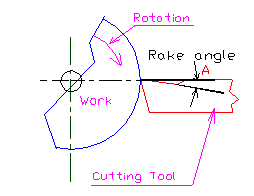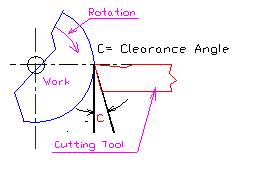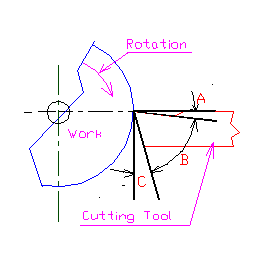Leaving Certificate Engineering
Machining Tool Angles
Home
Cutting Tool Angles
There are Three main angles on a single
point cutting tool Point, Rake
and Clearance.
A constant compromise is taking place when
deciding the correct angles for a cutting tool. The angles are dependent mainly on the
type of material being cut and the shape of the material. In general it is best to keep
the Tool angle as large as possible but good cutting will not take place without having
sufficient rake and clearance.
The Rake
Angle
 |
- The Rake. This is indicated by
"A" and the alows the chip to flow away.
This is ground to suit the material being cut
and the greater the rake the easier it is to cut but the weaker the cutting tool.
A rake angle of 20º is used for
mild steel and an angle of 5º is used for cast iron. Negative rake is used on
very hard materials.
|
The Point
Angle.
 |
- The Point Angle. This is often
called the tool or wedge angle and is indicated by "B"
- The point is the visible angle when we look at any cutting
tool and gives the cutter its body and strength.
- The greater the point or wedge angle, the stronger the cutter
but it is more difficult to push into the work-piece.
|
The
Clearance Angle.
 |
- The Clearance Angle. This
ensures that only the cutting edge touches the work-piece Angle "C
- If the flank of the cutting tool came into contact with the
work the cutting edge could not take off a chip.
- The larger the clearance the greater the tendancy of the
cutter to dig in.
|
Point,
Rake and Clearance.
 |
The simplest form of a cutting tool has three
main angles which make up 90º
The Point. This
is often called the tool angle and is indicated by "B"
The Rake. This
is indicated by "A" and the alows the chip to flow away.
The Clearance.
This ensures that only the cutting edge touches the work-piece Angle "C"
|
| Paddy Keays Engineering Teacher |
Cresent College Comprehensive Limerick Ireland |
| Last updated 10th February 2004. |
Comments to:- email paddykeays@eircom.net |
|



